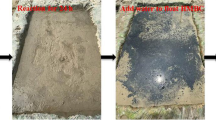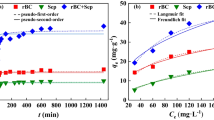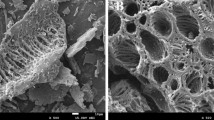Abstract
Cadmium-contaminated soils are an urgent problem that needs to be solved in many countries and regions. In this study, a new heavy metal passivator, micro-nano nitrogen-doped biochar (Nm-NBC), was prepared by introducing nitrogen into biochar. Soybean was used as an experimental plant to compare the effects of corn straw biochar (CBC, not modified), ammonium chloride modified corn straw biochar (NBC), and micro-nano nitrogen-doped biochar (Nm-NBC) on the remediation of Cdcontaminated soil. The results showed that the biomass of soybean, pH, organic matter, and total nitrogen content of the Cd-contaminated soil significantly increased, and the available Cd in soil significantly reduced (P < 0.05) when CBC, NBC, and Nm-NBC were added. The effect was as follows: Nm-NBC > NBC > CBC; Nm-NBC had the best result. When 1% Nm-NBC added to the soil, the Cd content in beans reduced by 68.09%. BET, FTIR, XPS, and SEM were used to analyze the characteristics of Nm-NBC and its mechanisms in the remediation of Cd-contaminated soils. The results showed that Nm-NBC had larger specific surface area and abundant functional groups; -COOH and graphitic nitrogen in Nm-NBC can form Cd–O bond and Cd-π with Cd(II) in the soil. Therefore, Nm-NBC prepared by introducing nitrogen into biochar has a promising application in the remediation of Cd-contaminated soil.








Similar content being viewed by others
Data availability
All data generated or analyzed during this study are included in this article.
References
Bolan N, Kunhikrishnan A, Thangarajan R, Kumpiene J, Park J, Makino T, Kirkham MB, Scheckel K (2014) Remediation of heavy metal(loid)s contaminated soils - to mobilize or to immobilize? J Hazard Mater 266:141–166
Chen G, Feng T, Li Z, Chen Z, Chen Y, Wang H, Xiang Y (2017) Influence of sulfur on the arsenic phytoremediation using Vallisneria natans (Lour.) Hara. Bull Environ Contam Toxicol 99:411–414
Chen G, Ran Y, Ma Y, Chen Z, Li Z, Chen Y (2021a) Influence of Rahnella aquatilis on arsenic accumulation by Vallisneria natans (Lour.) Hara for the phytoremediation of arsenic-contaminated water. Environ Sci Pollut R 28:44354–44360
Chen X, Lewis S, Heal KV, Lin Q, Sohi SP (2021b) Biochar engineering and ageing influence the spatiotemporal dynamics of soil pH in the charosphere. Geoderma 386:114919
Chen Z, Liu T, Tang J, Zheng Z, Wang H, Shao Q, Chen G, Li Z, Chen Y, Zhu J, Feng T (2018) Characteristics and mechanisms of cadmium adsorption from aqueous solution using lotus seedpod-derived biochar at two pyrolytic temperatures. Environ Sci Pollut R 25:11854–11866
Hamid Y, Liu L, Usman M, Tang L, Lin Q, Saqib Rashid M, Ulhassan Z, Hussain MI, Yang X (2022) Organic/inorganic amendments for the remediation of a red paddy soil artificially contaminated with different cadmium levels: leaching, speciation, and phytoavailability tests. J Environ Manag 303:114148
Huang L, Yang X, Xie Z, Li S, Liang X, Hu Z (2021) Residual effects of sulfur application prior to oilseed rape cultivation on cadmium accumulation in brown rice under an oilseed rape-rice rotation pot experiment. Ecotox Environ Safe 225:112765
Kapoor D, Singh S, Ramamurthy PC, Jan S, Bhardwaj S, Gill SS, Prasad R, Singh J (2021) Molecular consequences of cadmium toxicity and its regulatory networks in plants. Plant Gene 28:100342
Kasera N, Hall S, Kolar P (2021) Effect of surface modification by nitrogen-containing chemicals on morphology and surface characteristics of N-doped pine bark biochars. J Environ Chem Eng 9:105161
Kubier A, Wilkin RT, Pichler T (2019) Cadmium in soils and groundwater: a review. Appl Geochem 108:104388
Li J, Xia C, Cheng R, Lan J, Chen F, Li X, Li S, Chen J, Zeng T, Hou H (2022) Passivation of multiple heavy metals in lead-zinc tailings facilitated by straw biochar-loaded N-doped carbon aerogel nanoparticles: mechanisms and microbial community evolution. Sci Total Environ 803:149866
Liang J, Li X, Yu Z, Zeng G, Luo Y, Jiang L, Yang Z, Qian Y, Wu H (2017) Amorphous MnO2 modified biochar derived from aerobically composted swine manure for adsorption of Pb(II) and Cd(II). ACS Sustain Chem Eng 5:5049–5058
Liu L, Li J, Yue F, Yan X, Wang F, Bloszies S, Wang Y (2018) Effects of arbuscular mycorrhizal inoculation and biochar amendment on maize growth, cadmium uptake and soil cadmium speciation in Cd-contaminated soil. Chemosphere 194:495–503
Lv G, Yang T, Chen Y, Hou H, Liu X, Li J, Wei L, Li J (2021) Biochar-based fertilizer enhanced Cd immobilization and soil quality in soil-rice system. Ecol Eng 171:106396
Popov AA, Mirkov I, Tucovic D, Kulas J, Zeljkovic M, Popovic D, Ninkov M, Jankovic S, Kataranovski M (2021) Immunomodulation by heavy metals as a contributing factor to inflammatory diseases and autoimmune reactions: cadmium as an example. Immunol Lett 240:106–122
Ramanayaka S, Tsang DCW, Hou D, Ok YS, Vithanage M (2020) Green synthesis of graphitic nanobiochar for the removal of emerging contaminants in aqueous media. Sci Total Environ 706:135725
Riaz M, Roohi M, Arif MS, Hussain Q, Yasmeen T, Shahzad T, Shahzad SM, Muhammad HF, Arif M, Khalid M (2017) Corncob-derived biochar decelerates mineralization of native and added organic matter (AOM) in organic matter depleted alkaline soil. Geoderma 294:19–28
Shi Y, Gan L, Li X, He S, Sun C, Gao L (2018) Dynamics of metals in backfill of a phosphate mine of Guiyang, China using a three-step sequential extraction technique. Chemosphere 192:354–361
Sridhara Chary N, Kamala CT, Samuel Suman Raj D (2008) Assessing risk of heavy metals from consuming food grown on sewage irrigated soils and food chain transfer. Ecotox Environ Safe 69:513–524
Suhani I, Sahab S, Srivastava V, Singh RP (2021) Impact of cadmium pollution on food safety and human health. Current Opinion Toxicol 27:1–7
Wang T, Liu S, Mao W, Bai Y, Chiang K, Shah K, Paz-Ferreiro J (2020) Novel Bi2WO6 loaded N-biochar composites with enhanced photocatalytic degradation of rhodamine B and Cr(VI). J Hazard Mater 389:121827
Xi Y, Luo Y, Luo J, Luo X (2015) Removal of cadmium(II) from wastewater using novel cadmium ion-imprinted polymers. J Chem Eng Data 60:3253–3261
Xiu L, Zhang W, Wu D, Sun Y, Zhang H, Gu W, Wang Y, Meng J, Chen W (2021) Biochar can improve biological nitrogen fixation by altering the root growth strategy of soybean in Albic soil. Sci Total Environ 773:144564
Yang J, Chen M, Yang H, Xu N, Feng G, Li Z, Su C, Wang D (2020) Surface heterogeneity mediated transport of hydrochar nanoparticles in heterogeneous porous media. Environ Sci Pollut R 27:32842–32855
Yin W, Zhang W, Zhao C, Xu J (2019) Evaluation of removal efficiency of Ni(II) and 2,4-DCP using in situ nitrogen-doped biochar modified with aquatic animal waste. ACS Omega 4:19366–19374
Yu L, Yu M, Lu X, Tang C, Liu X, Brookes PC, Xu J (2018a) Combined application of biochar and nitrogen fertilizer benefits nitrogen retention in the rhizosphere of soybean by increasing microbial biomass but not altering microbial community structure. Sci Total Environ 640–641:1221–1230
Yu W, Lian F, Cui G, Liu Z (2018b) N-doping effectively enhances the adsorption capacity of biochar for heavy metal ions from aqueous solution. Chemosphere 193:8–16
Zhan J, Twardowska I, Wang S, Wei S, Chen Y, Ljupco M (2019) Prospective sustainable production of safe food for growing population based on the soybean (Glycine max L. Merr.) crops under Cd soil contamination stress. J Clean Prod 212:22–36
Zhang F, Wang X, Yin D, Peng B, Tan C, Liu Y, Tan X, Wu S (2015) Efficiency and mechanisms of Cd removal from aqueous solution by biochar derived from water hyacinth (Eichornia crassipes). J Environ Manage 153:68–73
Zhang H, Wang T, Sui Z, Zhang Y, Sun B, Pan W (2019) Enhanced mercury removal by transplanting sulfur-containing functional groups to biochar through plasma. Fuel 253:703–712
Zhang J, Huang D, Shao J, Zhang X, Zhang S, Yang H, Chen H (2022) A new nitrogen-enriched biochar modified by ZIF-8 grafting and annealing for enhancing CO2 adsorption. Fuel Process Technol 231:107250
Zhou J, Sui Z, Zhu J, Li P, Chen D, Dai Y, Yuan W (2007) Characterization of surface oxygen complexes on carbon nanofibers by TPD, XPS and FT-IR. Carbon 45:785–796
Zhu L, Tong L, Zhao N, Li J, Lv Y (2019) Coupling interaction between porous biochar and nano zero valent iron/nano α-hydroxyl iron oxide improves the remediation efficiency of cadmium in aqueous solution. Chemosphere 219:493–503
Zong Y, Xiao Q, Malik Z, Su Y, Wang Y, Lu S (2021) Crop straw-derived biochar alleviated cadmium and copper phytotoxicity by reducing bioavailability and accumulation in a field experiment of rice-rape-corn rotation system. Chemosphere 280:130830
Funding
This work was supported by the Scientific Research Foundation of Hunan Provincial Education Department (No. 21B0451), the Teaching Research and Reform Project of Hunan Province (HNJG-2022–0174), and the National Natural Science Foundation of China (No. 41501343).
Author information
Authors and Affiliations
Contributions
Guoliang Chen: conceptualization, methodology, writing-reviewing and editing. Yongqing Ma: experiments, formal analysis, data curation, writing-Original draft. Wenting Xu: experiments. Zhang Chen: writing-reviewing. Zhixian Li: writing-reviewing. Jianlin Zhou: writing-reviewing; Weijian Yu: writing-reviewing.
Corresponding author
Ethics declarations
Ethics approval
The submitted study has not been published elsewhere in any form or language (partially or in full).
Consent for publication
The authors give their consent for submission and publication.
Competing interests
The authors declare no competing interests.
Additional information
Responsible Editor: Zhihong Xu
Publisher's note
Springer Nature remains neutral with regard to jurisdictional claims in published maps and institutional affiliations.
Rights and permissions
Springer Nature or its licensor (e.g. a society or other partner) holds exclusive rights to this article under a publishing agreement with the author(s) or other rightsholder(s); author self-archiving of the accepted manuscript version of this article is solely governed by the terms of such publishing agreement and applicable law.
About this article
Cite this article
Chen, G., Ma, Y., Xu, W. et al. Remediation of cadmium-contaminated soil by micro-nano nitrogen-doped biochar and its mechanisms. Environ Sci Pollut Res 30, 48078–48087 (2023). https://doi.org/10.1007/s11356-023-25674-6
Received:
Accepted:
Published:
Issue Date:
DOI: https://doi.org/10.1007/s11356-023-25674-6




